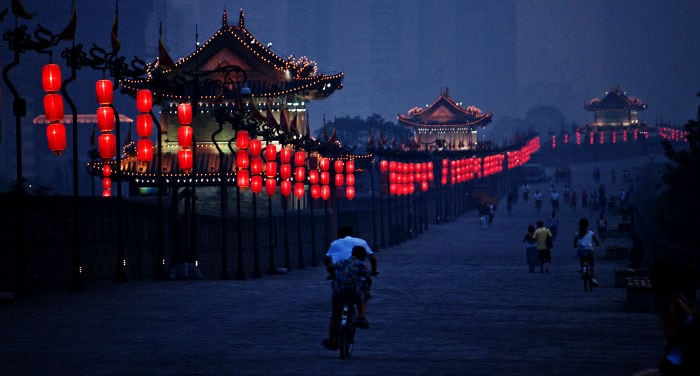
Xi’an is the capital of the Shaanxi province (not to be confused with Shanxi), and is one of the former imperial capitals. However, it is not the only former imperial capital of China, although the majority of them (Anyang, Kaifeng, Zhengzhou, and Luoyang) are found in the neighboring Henan province.
Nonetheless, after Beijing and Shanghai, Xi’an is probably the best-known city in China, and the Terracotta Warriors, a World Heritage Site since 1987, is without a doubt its most popular tourist attraction. This guide tries to give all the information necessary for you to enjoy this emblematic city.
Below is a list of subjects covered in this guide. You can click on the titles to skip directly to the section that interests you:
Before getting started
The information that you will find here is intended to go into much greater detail than then numerous guides that exist on websites of bloggers who have stayed in the city for a maximum of three days. This guide is based on my personal experience – I have visited the city on four occasions: in 2005, 2009, 2011, and 2016 – as well as a great deal of research, in which I consulted many sources in both English and Chinese.
Last of all, this guide contains all of the practical information necessary to organize your visit. Don’t expect to find historical or demographic information. For that, you can read articles written for people interested in the subject, such as the extensive articles you can find on Wikipedia.
When to go to Xi’an
Xi’an is one of the best known and most touristy cities in China, likewise among Chinese tourists. Because of this, it is recommendable that you avoid visiting the city during national holidays, in particular the first week of October. During national holidays, the city is flooded with Chinese tourists, and becomes impossible to visit. In the summer, from mid-July to late August, there is also a large influx of tourists, in particular students.
Xi’an has a continental climate with sweltering summers (June – August) and relatively cold winters (December – February) which are very dry and have constant fog. The best time to visit Xi’an is in mid-fall (October) when rain is less frequent and during pleasant spring temperatures (April, May). Even so, in the spring, there may be sand storms, although they are not very common.
How to get to Xi’an
Xi’an is very well-connected with the main cities in the country both by air and land. While planes are always an option, Xi’an is conveniently connected to Beijing and Shanghai via bullet trains that take six and seven hours, respectively.
Plane
Xi’an Xianyang International Airport (西安咸阳国际机场): Xianyang Airport is located 41 kilometers from downtown Xi’an, and is the airport with the largest volume of traffic in the northwestern part of the country, with numerous daily flights to the main cities in the country, and offering connections with smaller cities in the northwest, such as Dunhuang. In addition, it also has multiple international connections with many Asian countries and even Europe.
Remember that Xianyang Airport is included on the list of airports in which you can obtain a 72 hour visa extension. You can find more information on this type of visa in this article.
To get to downtown, there are various means of transportation:
- Taxi: If there isn’t a lot of traffic, it takes less than 50 minutes to get to downtown. The price should not be more than 150 Yuan.
- Shuttle buses: There are more than 15 shuttle bus lines that connect the airport to different parts of the city. The price is approximately 25 Yuan.
- Buses to other cities: There are buses that connect the airport with nearby cities such as Baoji, Hancheng, Tianshui, Tongchuan, Weinan, Yan’an, and Yangling, among others.
For more information and advice on how to book domestic flights within China, I recommend you take a look at this article.
Train
There are two train stations in Xi’an:
Xi’an Railway Station (西安站): Located very close to the North Gate of the city wall, it is the main and oldest station in Xi’an. This station connects the city with all of the main cities in the country via slow K-class trains. In front of the station is the Shaanxi bus station, where you can take buses to multiple cities, as well as where you can take tourist buses to Mount Huashan and the Terracotta Warriors.
This station is very busy as well as old, because of which it is not well-organized. So, if you need to take a train or do any paperwork, get there early.
Xi’an North Railway Station (西安北站): This newly-built station is located in the outskirts of the city (14 km from downtown). It was built to receive bullet trains from Beijing, Shanghai and Guangzhou. Getting downtown from this station only takes 40 minutes, and taxis cost less than 50 Yuan. You can also take the subway downtown.
To find out how to book train tickets in China, I recommend you read this article.
Bus
This is the least recommendable mode of transportation, especially if you don’t speak Chinese. Taking long-distance buses in China can be complicated, as the information available (even in Chinese) tends to not be exact, and schedules tend to not be well-established.
In Xi’an, there are numerous long-distance bus stations, the main one of which is Shaanxi Station, which connects to multiple destinations, including in the provinces of Shanghai, Shandong, Henan, Sichuan, Gansu and Tibet. From Xi’an, you can get to almost any part of the country by bus.
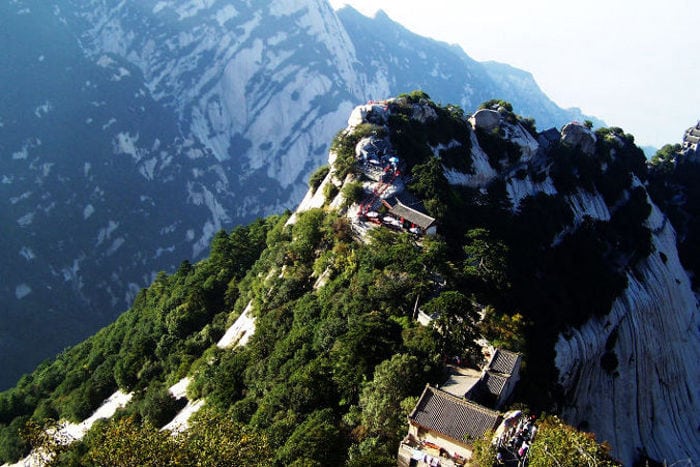 Mount Hua
Mount Hua
Where to stay in Xi’an
Xi’an has a broad offering of lodging for all budgets, although the best hotels tend to be booked up quickly. My recommendation is that you try to choose accommodations within the walls of the city to be able to stay in the southern part. Xi’an is an enormous city, and if you want to enjoy the local nightlife and food, the best place is within the walled city.
You can check the list of hotels we recommend in Xi’an by clicking here. In it, you will find a review of the best hotels in Xi’an depending on your budget. If you want a complete list of hotels in the city, click here.
Getting around in Xi’an
Xi’an is a relatively large city, and to get to many places in the city, you will need to take some means of transportation. Below, I detail the transportation methods available.
Taxi
Getting around via taxi in China is simple, comfortable, and relatively cheap. In Xi’an, taxis cost 9 Yuan for the first three kilometers (10 during the night), and an additional 2 Yuan per extra kilometer, up until 12 kilometers, at which point they cost 3 Yuan per kilometer.
Remember that taxi drivers don’t speak English, so you should always show them the address or place written in Chinese characters.
Last of all, you should keep in mind that at certain times of the day, it may be difficult to find available taxis, especially around the times people go to and leave work, as well as when public transportation is already closed.
Subway
Currently, Xi’an only has two subway lines, which cross the city from north to south (line 1) and from east to west (line 2). The third line will open up soon, which will go from northeast to southwest. Line 4 is being planned for 2018. In 2030, 17 subway lines are foreseen.
As it is still being built, the Xi’an subway system is not useful for getting to many places. However, it can be useful for going from downtown to certain attractions, such as the Shaanxi History Museum, which are located outside of the walled central zone.
The price of tickets ranges from 2 Yuan to 5 Yuan depending on the number of stops.
Bus
The network of urban buses is very extensive, and although buses are useful for getting to any part of the city, if you don’t speak Chinese, it’s not a good idea to use them. Most likely you won’t know where you are going. The price may vary depending on the distance.
Tourist buses
There are 10 tourist bus lines which take you to places outside of the city, such as Mount Hua, the Terracotta Warriors or Huaqing Hot Springs. Tourist buses are easy to identify because the bus line number is preceded by the character for tourism (游).
The majority of tourist buses can be found at the bus stop of the eastern plaza in front of the old train station. They tend to be well-marked with the destination in Chinese and English. Many of these buses don’t have any established schedule, and only leave when they are full.
Transportation card
Last of all, if you are going to spend multiple days in the city and are going to use public transportation, I recommend you get a Chang’An Tong Ka (长安通卡) or Xi’an Public Transportation Card. This is a re-loadable card and is similar to the other magnetic cards in main Chinese cities. It costs 22 Yuan (refundable) and with it, you will get a discounted rate on the subway and urban buses. In addition, you can use it to pay for taxis or public bicycles.
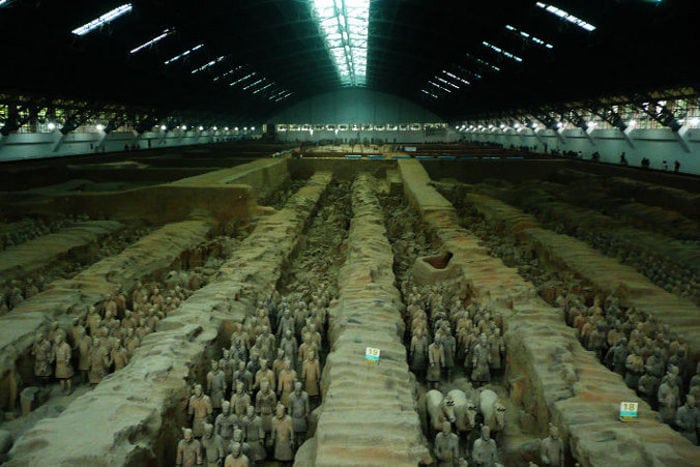 Terracotta Warriors
Terracotta Warriors
What to see and do in Xi’an
Xi’an is a large and dynamic city with a lot of history, which means there is a never-ending list of interesting places to see and activities. Below, I detail the top 20 in my opinion.
1. The Terracotta Warriors (兵马俑)
Officially called the Mausoleum of the Emperor Qin Shihuang (秦始皇帝陵博物院), it is a UNESCO World Heritage Site and is the reason why tourists visit Xi’an.
The museum has undergone many reforms in the past years. Currently, there are three shafts in which you can see the warriors and three specific sections dedicated to carriages and civil figures, as well as one exhibition with replicas of the warriors with their original colors.
Keep in mind that it is very frequented by tourists, and a whole city has sprung up around it to take advantage of the business this brings. In addition, the reforms made to the museum over the past years to permit a larger amount of tourists and to maximize earnings have turned the place into somewhat of a theme park. Because of this, many travelers end up disappointed by their visit. However, the Terracotta Warriors continues to be an emblematic site in the city, and is a “must-see” attraction.
Address: Litong District, Xi’an (陕西省西安市临潼区).
Price of entry: 120 Yuan (March 16 to November 15), 150 Yuan (November 16 to March 15).
How to get there: The Terracotta Warriors is located in the Litong district around 41 kilometers form downtown Xi’an. The easiest way to get there is Bus 306路 (or tourist bus No. 5, 游5) which you can take at the plaza in front of the train station (close to the North Gate). You can also take buses 915路 and 914路. The schedule of the 306 going there is from 7:00 to 19:00 and is from 8:10 to 19:00 p.m. coming back. It costs approximately 7 Yuan.
Schedule: Low season: 8:30 – 18:05 p.m. (tickets until 16:30); high season 8:30 – 18:35 (tickets until 17:00)
2. Muslim Quarter
In my opinion, one of the essential places to visit in Xi’an is the Muslim Quarter, where many of the Hui ethnicity Chinese in the city work and live. This district is a special place to enjoy Muslim Chinese food and to see one of the oldest districts in the city, which still maintains a part of its traditional way of life. In addition, it has one of the most-visited bazaars for tourists in the city.
Address: North of Xi Avenue (西大街)
How to get there: To get there, simply walk towards Drum Tower and behind the tower, you will find a multitude of alleyways to the west that lead to the quarter.
3. Mount Hua (华山)
If you have one or two free days in Xi’an, Mount Hua is one of the most beautiful natural areas in China, and you shouldn’t miss it. Mount Hua is also famous for having the “second most dangerous trail in the world.”
For its address, entry price, information on how to get there and hours of operation, you can read our complete article on Mount Hua.
4. The Great Mosque (西安大清真寺)
Located within the Muslim Quarter of Xi’an, the Great Mosque was built during the Tang Dynasty (VIII century A.D.) and is one of the most beautiful parts of the city. The feature that makes it unique is its mixture of Islamic architecture and the architecture typical of Chinese temples. Despite its name, the Mosque isn’t very big, and can be easily visited in less than an hour.
Address: 30, Huajue Alley (化觉巷30号)
Price of entry: 15 Yuan (high season) 25 Yuan (low season)
How to get there: You can easily get to the Great Mosque from Drum Tower. It is located only 300 meters northwest of the tower.
Hours of operation: 8:00 – 19:00
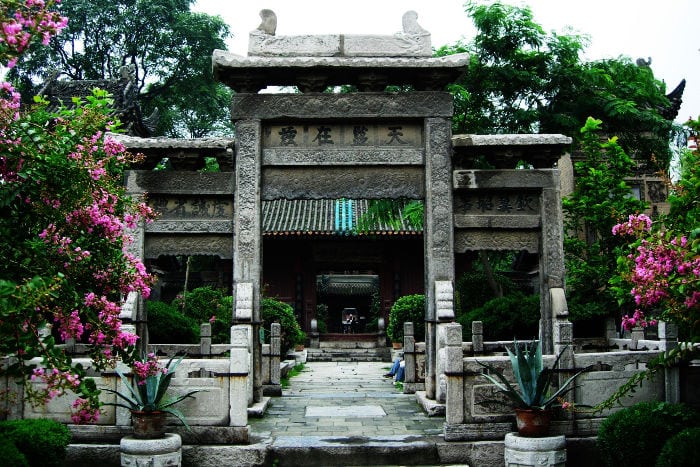 Great Mosque main entrance
Great Mosque main entrance
5. Walking along the walls of the city
Xi’an is one of the few Chinese cities whose ancient walls remain intact. In fact, the Wall of Xi’an along with the Walls of Nanjing and Jingzhou have been declared a UNESCO World Heritage Site.
The wall has been restored, and you can walk on its upper section. Walking along the wall is without a doubt one of the best activities to do, and will give you a unique view of the city. It’s best to visit it at sunset, when lights are turned on offering spectacular views, as can be seen in the first photo of the article.
The wall surrounding the city center is rectangular, and the walk is around 14 kilometers, because of which it takes around 4 hours to cover it on foot. There is also the possibility of renting a bicycle, with which you can cover the whole wall in one hour. To rent a bicycle, it is best to access the wall by the South Gate. The price is around 45 Yuan for two hours, and you need to leave a 200-Yuan deposit. If you don’t feel like walking or riding a bike, there is also the option of an electric car.
Price of entry: 45 Yuan.
How to get there: The wall can be accessed from different city gates, but not all of them. The gates that allow you to access the wall are the following: East Gate (东门), South Gate (南门), West Gate (西门), North Gate (北门), Heping Gate (和平门), Wenchang Gate (文昌门), Hanguang Gate (含光门), and Shangde Gate (尚德门).
Hours of operation: Each gate has its own hours of operation. The South Gate is the one with the longest hours of operation, opening from 8:00 to 22:00.
6. Hanyangling Museum (汉阳陵博物馆)
If you still feel like more after the Terracotta Warriors, I recommend that you visit Hanyangling Mausoleum, the tomb of the Han Dynasty Emperor Liu Qi and his wife. This mausoleum holds an enormous collection of very well-conserved terracotta figures. As opposed to the Terracotta Warriors, here, the main subject matter is civil figures, and they are a bit smaller.
Given the fact that the Terracotta Warriors has turned into a sort of theme park, many people find that this mausoleum is more spectacular than the Warriors themselves. Personally, I appreciate the absence of hordes of tourists, and was impressed by the state of conservation of the figures.
Hanyangling Museum is located in the outskirts of Xi’an, around 20 kilometers from the city, in the Xianyang district.
Address: Airport Highway, Weicheng, Xianyang (西安咸阳国际机场专线公路东段)
Price of entry: From March to September: 90 Yuan; December, January and February: 65 Yuan.
How to get there: The easiest way to get there is to take tourist bus number 4 (游4) which is located close to exit D of the City Library Station (市图书馆站) subway stop. The bus takes around 40 minutes to get there, and costs around 2 Yuan. There is only one bus per hour, and the schedules are the following: From Xi’an, they leave at 8:30, 10:20, 12:00, 13:40, 15:20 and 17:00 and from the museum at 9:30, 11:10, 12:50, 14:30, 16:10, and 18:00. Keep in mind that this the “official” schedule, but it may vary depending on the season or the amount of users.
Hours of operation: From March to September from 8:30 to 19:00 (entry tickets are sold until 17:30), January and February from 8:30 to 18:00 (entry tickets are sold until 17:00).
7. Calligraphy Street (书院门步行街)
Calligraphy Street is an excellent place to walk around and buy souvenirs. The aptly-named Calligraphy Street is an area where buildings have been restored maintaining their original appearance, and in which numerous artists who sell their calligraphy and classical painting works live. Over time and with the increase in tourism to the city, many other types of vendors have also set up shop here.
Although the street is quite touristy, it’s worth visiting to enjoy the work of the artists and artisans, who give a glimpse of Classic Chinese culture.
Address: Shuyuanmen buxing Road (书院门步行街)
How to get there: From the South Gate, it’s the first street to the east (within the walls).
8. Bell and Drum Towers (钟楼, 鼓楼)
In all ancient Chinese cities, there was a Drum Tower and a Bell Tower. They had a use similar to that of bell towers in the West, as they were used to tell time and as musical instruments. In Xi’an, these two towers are some of the most spectacular in the country, both because of their size and the fact they are well-restored. However, urban development in the city has taken away much of their charm.
Address: Drum Tower, Gulou (鼓楼). Bell Tower, Zhonglou (钟楼).
Price of entry: 50 for both or 35 Yuan each.
How to get there: You can easily reach them via subway (the Zhonglou stop 钟楼站) or by walking north from the South Gate. Given their size, they are hard to miss.
Hours of operation: From April 1 to October 25 from 8:30 to 21:30. From October 26 to March 31, from 8:30 to 18:00.
9. The Giant Wild Goose Pagoda (大雁塔) and Da Ci’en Temple (大慈恩寺)
Built during the Tang Dynasty in the XVII century, the Da Ci’en Buddhist Temple is famous for being home to the Giant Wild Goose Pagoda, an enormous 65-meter high monument and a symbol of Buddhism and the Silk Road.
This temple is located four kilometers to the south of historic downtown.
Address: Yanta District Da Ci’en Temple (雁塔区大慈恩寺内)
Price of entry: Entry to the temple: 50 Yuan; entry to the Pagoda: 40 Yuan
How to get there: The easiest way to get there is by taking the subway and walking to exit C of the Xiaozhai Station (小寨站) stop. You can also take buses 5, 19, 21, 22, 27, or 41 and get off at Dayan ta Station (大雁塔站).
Hours of operation: 8:00 – 17:00
10. Huaqing Hot Springs (华清池)
Built during the Western Zhou Dynasty (XI – VII century A.D.) and expanded during the Han and Qing Dynasties, these hot springs are a nice place to visit before going to see the Terracotta Warriors. The hot springs are located in the Litong District 30 kilometers from Xi’an, halfway between Xi’an and the Mausoleum of Emperor Qin Shihuang.
Address: 38 Huaqing Road, Lintong (临潼区华清路038号)
Price of entry: From March to November: 150 Yuan; December, January and February: 120 Yuan.
How to get there: The easiest way to get there is to take the same bus that goes to the Terracotta Warriors, number 306 or 游5, and to get off at the Huaqingshi stop (华清池站).
Hours of operation: 7:30 – 18:30
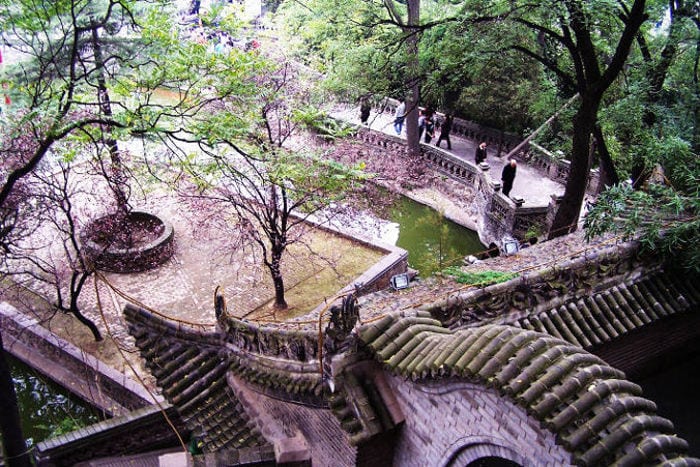 Huaqing hot springs
Huaqing hot springs
11. Banpo Museum (半坡博物馆)
This museum was built on top of the Banpo archaeological site, a neolithic town over 6,000 years old. The possibility of seeing excavations and the broad exposition of ceramic pieces make it an ideal place for people who love archeology.
Address: 155 Banpo Road, Xi’an Dongjiao (西安市东郊半坡路155号)
Price of entry: From March to November: 35 Yuan; December, January, and February: 25 Yuan
How to get there: You can take buses 15, 406, 91, 11, 42, 105, 323, 241, 401, 511, or 715 and get off at the Banpo stop (半坡站). Even so, the easiest way to get there is to take subway line 1 to Banpo Station (半坡站). If you leave via exit A, the museum will be around 500 meters from you. To get to the museum, walk west until Banpo Street (半坡路).
Hours of operation: From March to November from 8:00 to 18:00; December, January and February from 8:00 to 17:30.
Website:
12. Beiyuanmen Night Market (北院门夜市)
If you want to taste Xi’an’s famous Muslim food, one of the best options is to go to Beiyuanmen Night Market around sunset to try the different street food options offered. The market stretches from the street behind Drum Tower (north) up until the Beiyuanmen Arch.
Nonetheless, you should keep in mind that a large number of tourists visit this market, so prepare for a bit of a fight to get that special snack.
Address: Guloubei, Beiyuanmen (鼓楼北,北院门)
How to get there: The market is located behind Drum Tower, right where the Muslim Quarter starts. The easiest way to get there is by subway, getting off at the Zhonglou stop (钟楼站).
13. The Qianling Mausoleum (乾陵博物馆)
The Qianling Mausoleum of the Tang Dynasty is the tomb of Emperor Gaozong and his wife, the extremely famous Wu Zetian, the only empress of China. The Mausoleum is located in the Qian District, 80 kilometers from Xi’an.
The Mausoleum is a huge complex that attempts to mimic the former imperial capital Chang’an (Xi’an), and is noteworthy for its stone sculptures and murals.
Given that it is somewhat hard to get there, and that it can take a long time to visit, I would only recommend it to history-lovers with enough time in the city, as there are more accessible places which are just as interesting.
Address: Qianling Maosoleum, Qian County, Xianyang City (咸阳市乾县城关镇永泰公主墓院内)
Price of entry: From March to November: 122 Yuan; December, January and February: 82 Yuan
How to get there: Take tourist bus 3 (游3) from Xi’an Train Station. The bus leaves at 8:00 and returns at 15:00 and costs 15 Yuan. Alternatively, you can take the subway to the Hancheng Road stop and take the long-distance bus from the West Bus Station (西汽车站) to the Qian District (乾县). Afterwards, take a minibus to the Mausoleum.
Hours of operation: From March to November from 8:00 to 18:00; December, January and February from 8:30 to 17:30
14. The Stele Forest (碑林)
The Stele Forest is a Confucionist temple from the Tang Dynasty which contains more than 3,000 stone tablets (the largest collection in the country) which date back from the Tang Dynasty to the Qing Dynasty (the IX to XX century).
Given its central location, this museum is a good option to include in your tourist route around the city. Nonetheless, it might not have the same spectacular feeling as the other historical sites previously mentioned.
Address: 15, Sanxue Street, Beilin District (碑林区三学街15号)
Price of entry: From March to November: 75 Yuan; December, January and February: 50 Yuan
How to get there: You can easily get to the Stele Forest via the south gate. Just follow Shuncheng East Street (顺城路东, the street bordering the wall to the east of the South Gate). Before reaching the Wenchang Gate (文昌门), to your left will be Sanxue Street. You can also get there via buses 14, 23, 40, 118, 208, 214, 221, 223, 232, 706, 402, 512, 619, 704 and 800 by getting off at the Wenchangmen stop (文昌门站).
Hours of operation: 8:00 to 17:30
15. Jianfu Temple and the Small Wild Goose Pagoda (荐福寺-小雁塔)
This Buddhist temple from the Tang Dynasty contains the Small Wild Goose Pagoda, which might not be as famous as its older counterpart. However, given that it’s less touristy, it’s more pleasant and peaceful to visit. It’s also a good place to watch locals use the park for their “leisure-sporting-cultural activities.”
Address: 72, Youyi Xi Road (友谊西路72号)
Price of entry: Free
How to get there: The north gate of the temple is located to the west of the Nanshaomen (南稍门站) subway stop, exits A1 or A2. Buses 18, 203, 204, 218, 21, 224, 29, 32, 407, 40, 410, 46, 508, 521, 700, 707, 713, 720, tourist 7 (游7), or tourist 8 (游8).
Hours of operation: 09:00 – 16:00
16. The Shaanxi History Museum (陕西历史博物馆)
The Shaanxi History Museum is one of the largest in the country and has a huge collection of more than 350,000 archaeological objects which range from prehistory to the Zhou, Qin, Han, and Tang Dynasties.
Address: 91, Xiaozhai Dong Road (小寨东路91号).
Price of entry: Free upon showing passport.
How to get there: The museum is located 800 meters from the Xiaozhai (小寨站) subway stop. You can also get there via buses 5, 19, 24, 26, 27, 30, 34, 400, 401, 521, 527, 701, 710 and 722.
Hours of operation: Open every day except Monday. From November 15 to March 15 from 9:00 to 17:30 (the entrance is closed at 16:00); From March 16 to November 14, from 8:30 to 18:00 (the entrance is closed at 16:30).
Website: https://www.sxhm.com/en/index.html
17. Famen Temple (法门寺)
Located in the city of Baoji, 120 kilometers from Xi’an, Famen Temple is famous because it contains the remains of one of Buddha’s finger bones. In addition, the temple is an enormous complex with more than 1,700 years of history, and is one of the most important historical sites in the Shaanxi province.
Address: Famen Town, Fufeng County, Baoji City (宝鸡市扶风县法门镇).
Price of entry: From March to November: 120 Yuan; December, January and February: 90 Yuan
How to get there: To get there, you can take tourist bus number 2 (游2), which leaves from the Xi’an train station at 8:00 and returns at 15:00. It costs around 25 Yuan.
Hours of operation: From March to November from 8:30 to 19:00; December, January and February from 9:00 to 18:00.
18. The Daming Palace (大明宫)
The Daming Palace is a museum and archaeological excavation site which was opened up to the public in 2010. The Daming Palace was the imperial palace during the Tang Dynasty for over 200 years, and is considered to be the design that inspired the construction of Beijing’s Forbidden City. It was discovered in 1957, and its excavation and restoration have involved the collaboration of UNESCO.
Address: 585, Ziqiang Dong Road, Xīncheng District (新城区自强东路585号)
Price of entry: 60 Yuan
How to get there: Take the subway to the Anyuanmen stop (安远门站). The palace is located 1.5 kilometers away if you leave via door D heading east (you can take bus number 2). You can also take buses 2, 262, 528, 717, 723, 17, 22, 46, 104, 209, 216, 2613, and 309.
Hours of operation: 9:30 -18:00
19. Tang-Style Commercial & Cultural District (大唐不夜城)
As its name says, this neighborhood, which is located very close to the Giant Wild Goose Pagoda, has been built in the classical style of the Tang Dynasty both in its buildings and its numerous sculptures. In this neighborhood, you will find things ranging from shopping malls, a street of bars and karaoke, an art museum, a concert hall, a movie theater and numerous restaurants. It is definitely a good place to spend a night.
Address: Qujiang Xi New District (曲江新区西部)
How to get there: The easiest way to get there is to take the subway and walk east from exit C of the Xiaozhai Station (小寨站) stop. Once you reach the Giant Pagoda, the neighborhood is to the south. You can also take buses 5, 19, 21, 22, 27, or 41 and get off at Dayanta Station (大雁塔站).
Hours of operation: It’s best to visit it at night, when the lights are turned on.
20. Going to bars at the South Gate
Xi’an has a vibrant nightlife, and in historic downtown, there are tons of bars and pubs, especially close to the South Gate. The problem with many of these bars is that they are oriented towards the new Chinese upper class, and might not be the most appropriate for international travelers. The Chinese concept of nighttime fun is very different from that in the West.
Nonetheless, in Xi’an, there are also various bars which are more in tune with the standards of foreigners, where you can peacefully drink a beer. Some of these bars are close to the South Gate in the western area, close to the International Hostel (which also has a nice bar).
Address: Shuncheng Road Xi (顺城路西)
How to get there: To get there, the only thing you have to do is walk along the first street to the west of the South Gate (along the wall) until you reach the International Hostel, where you can go to a bar or simply explore the nearby alleyways, where other pleasant bars can be found.
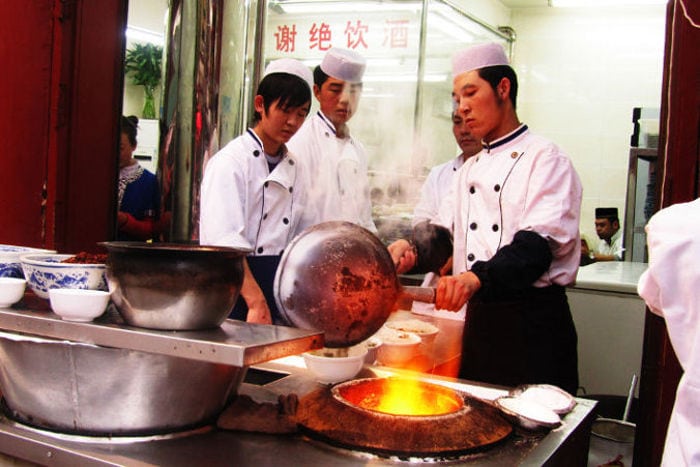 Muslim quarter
Muslim quarter
Food
Food in Xi’an is famous throughout the country. Below, I detail some of the dishes and snacks that you can’t miss.
Lamb soup with bread (羊肉泡馍): This is one of the most famous dishes from Xi’an. It is a lamb noodle soup that is accompanied with a delicious flat roll.
Chinese hamburger (肉夹馍): If there is a star of street food in Xi’an, it is the not-so-appropriately-named Chinese hamburger or rojiamuo. It is a roll stuffed with pork which is slow-boiled and spiced up, and is a real delight.
Lamb skewers (羊肉串): Like in any city in northeastern China where there is a Muslim population, lamb skewers are an essential dish.
Cold noodles (凉皮): These are cold noodles which are served with a spicy and slightly sweet sauce, typical of the provinces of Shaanxi and Henan. Personally, I prefer another type of cold noodles called Ganmianpi(r) (擀面皮), which are also typical of those two provinces.
Biangbiang Noodles (Biangbiang面): This dish is famous because its name is written with one of the most complex characters (consisting of 57 strokes, and which can’t be written with electronic devices). Without a doubt, it is one of the noodle dishes that you can’t miss.
Youpo Noodles (油泼面): These are very similar to the last dish, but personally, I think that they are much better. They are thick, hand-made wheat noodles which are served with a delicious sauce made from soy sauce and spicy oil.
Dumpling soup (酸汤水饺): These are dumplings made from lamb or veal which are served in a hot and sour soup.
Pomegranates (石榴): Pomegranates are one of the most famous crops in the Shaanxi province and in the city, you can find numerous appetizers made from this fruit.
This list could go on forever. Just enjoy the numerous dishes that the diverse gastronomy of the Shaanxi province has to offer.
I hope that you have a good time in the city, and if you have any questions or suggestions, leave a comment at the end of this article.
Photo Credits: ![]() Dusk atop the Xi’an City Wall by Jack Zalium
Dusk atop the Xi’an City Wall by Jack Zalium



